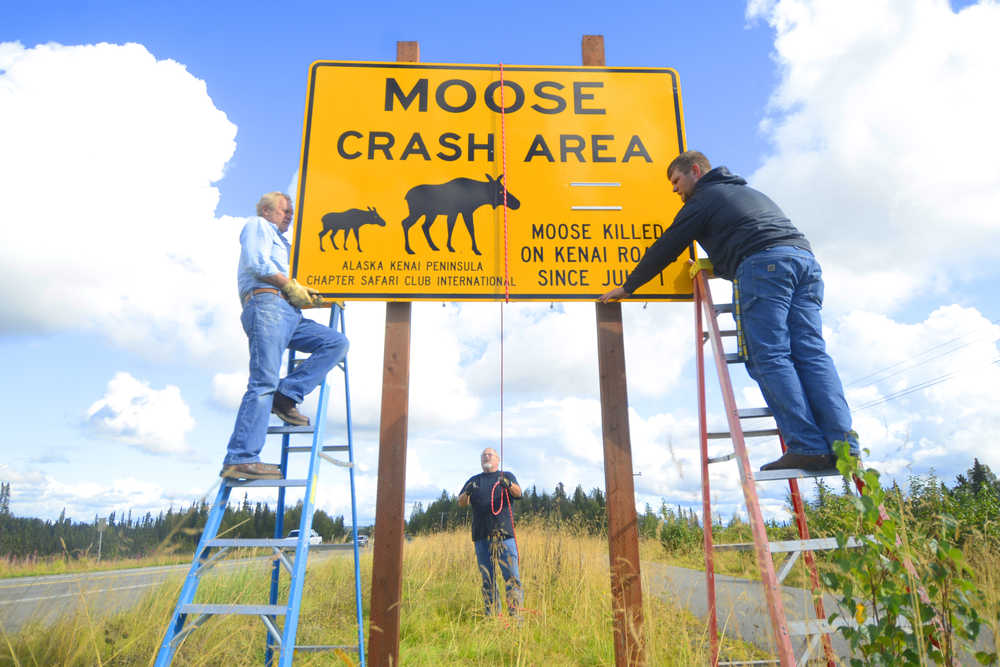Laurie Speakman can recall the perfect imprint of a body left on the hood of the car.
It was a collision on the list of nearly a dozen Speakman responded to last month that involved a motor vehicle hitting a moose. For the past three years she has responded to moose collisions in the Alaska Moose Federation’s statewide salvage program.
“It was as if it (the moose) was picked up and slammed down right on the front of the truck,” Speakman said. “The driver said the last thing he saw was the moose’s head and the next thing he knew he was in the ditch.”
Speakman said she has seen many wrecks where the car had to be hauled away with a tow truck, but generally the driver and passengers will walk away with bumps and scrapes. When she is called to a scene, it means the moose was not as fortunate.
Three volunteers clear carcasses in the central Kenai Peninsula area, including Speakman, who organizes salvaging in the region. Salvagers are called by the Alaska State Troopers dispatch at any time of day. Once procured, the body is transported to a local charity, where it is processed and the meat is donated to those in need.
As the hours of daylight decrease this fall, the frequency of moose crash kills will increase, Speakman said. This time of year especially, many of those deaths involve calves.
Spencie Netschert, president of the Alaska Kenai Peninsula Chapter Safari Club International said October through January are the months with the highest rates of moose crash kills.
As it gets darker commuters have a harder time spotting a moose exiting roadside brush to cross the highways, and when the roads get icy drivers have a harder time slowing down.
The Safari Club has erected six “moose crash kill” on central Kenai Peninsula Highways in areas that have high collision rates, Netschert said.
Soldotna area biologist for the Alaska Department of Fish and Game, Jeff Selinger, said moose hug the roadsides for survival purposes during the winter.
Roadways provide flatter, compact pathways for moose to walk along, Selinger said. Especially in deep snow, walking expends vital energy reserves. Their favorite food sources, such as defoliated willow, birch and aspen stands, are easier to come by near the road.
As of Aug. 22, 35 moose had already been killed in the central Kenai Peninsula Region, Selinger said. That number is only what has been reported to the Alaska State Troopers, he said. Some moose don’t die immediately and will wander away from the scene before they succumb to their injuries. And humans have to report the collision.
Kenai police received a report of a dead moose around Mile 8 of the Kenai Spur Highway at about 1:30 a.m. on Aug. 31. On the scene, officers noticed a trail of fluid leaving the area, which they tracked to a vehicle located outside a residence in the Valhalla subdivision, according to a Kenai Police report.
Kenai resident Brian Thigpen, 42, was arrested for driving under the influence and taken to Wildwood Pretrial, and the moose was picked up and donated to charity, according to the report.
Fish and Game estimates that 90 percent of moose killed by a vehicle on the Kenai Peninsula are cows and calves, according to a 2009 Progress Report on Wildlife Mitigation and Human Safety for the Sterling Highway. The number of collisions is also underreported.
The moose population in Game Management Unit 15A, the area north of the Kenai River and West of the mountains, is stable at best, Selinger said. But generally it is on the decline.
According to Fish and Game, known road kills account for about one-third of all moose killed by humans. In 2012, 66 moose were harvested on the Kenai Peninsula, and between July 1, 2012, and June 30, 2013 186 moose were killed on roadways.
Speakman said she has responded to collisions where the speed of the vehicle was 25-30 miles per hour, and still killed the moose.
Even breaking a leg can cause death from stress, she said. Slowing down and staying alert is the best way to avoid hitting a moose, she said.
Constantly scanning the roadsides while maintaining a safe speed, and not getting distracted will also help reduce moose collisions, Selinger said. Most important is slowing down, he said.
Kelly Sullivan can be reached at kelly.sullivan@peninsulaclarion.com.


